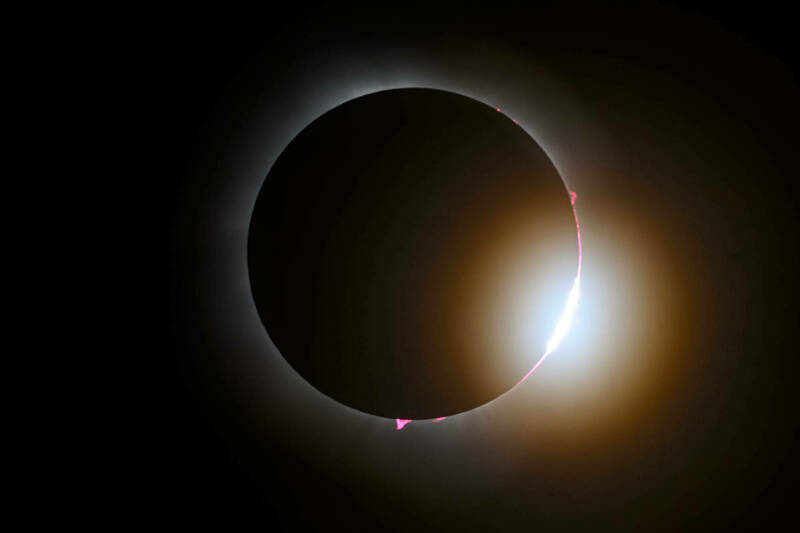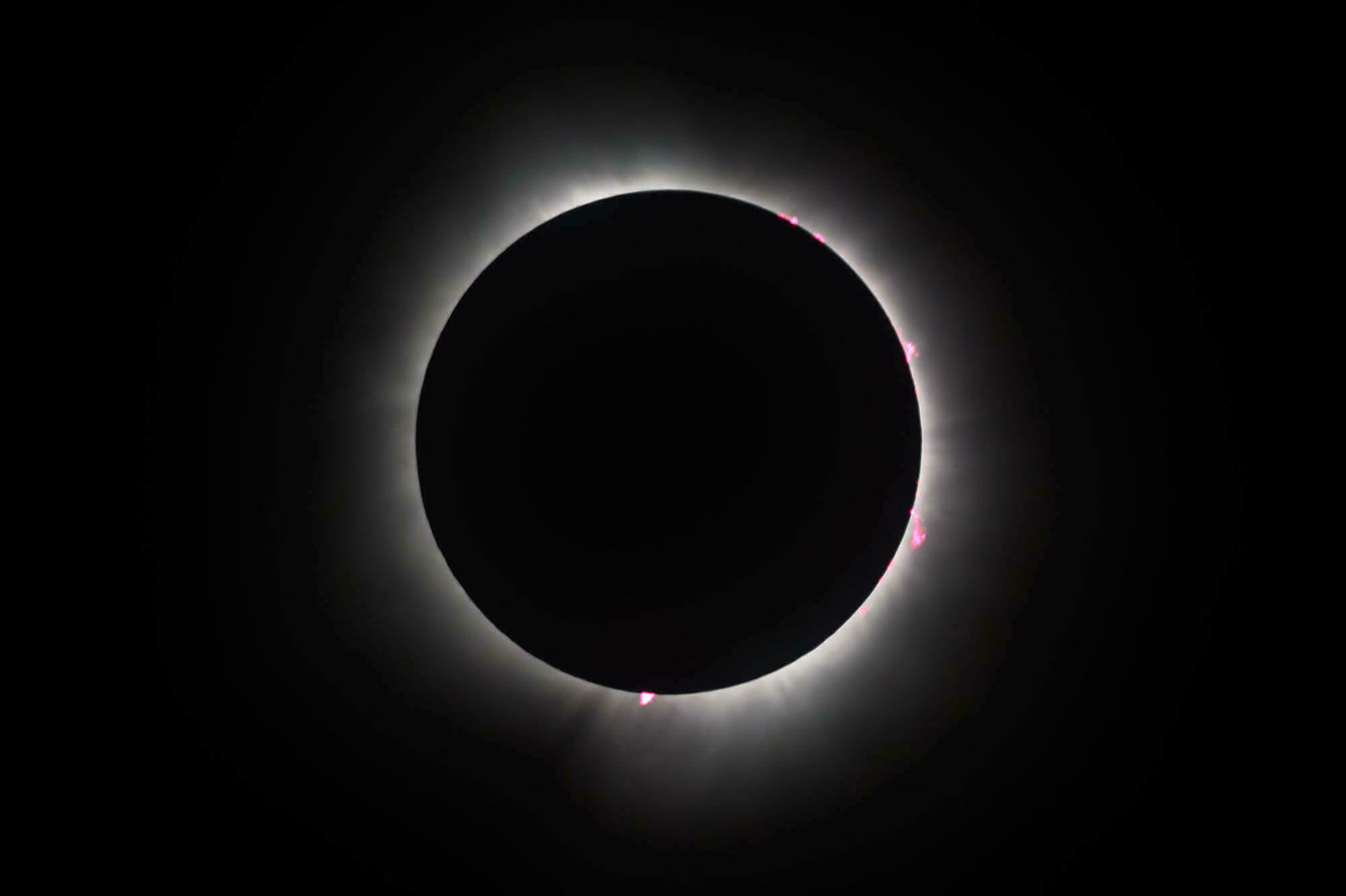 Photography by Matt Cashore ’94
Photography by Matt Cashore ’94
Expectations can let you down.
Maybe it was that longed for Christmas present, or a new movie or album, or a dream vacation. Not to mention the people in our lives.
I had great expectations in advance of traveling to Indianapolis to see a total solar eclipse on April 8. This time, the experience more than met my expectations.
I’m a bit of an astronomy and NASA buff. When someone recently asked me what I was reading, I got an odd look when I said a biography of Albert Einstein. It was a great read, though I didn’t understand much of the physics, even though it was written in layman’s terms. The same was true for Stephen Hawking’s A Brief History of Time and Neil deGrasse Tyson’s Astrophysics for People in a Hurry.
I’m even more enamored with the U.S. space program, from Mercury to Apollo to Space X, and everything in between. Watching, hearing and feeling a rocket lift off from Cape Canaveral in April of 2015 was a powerful and pulsating experience.
I’ve been fortunate and honored to help host astronauts on the Notre Dame campus — alumni Mike Good ’84, ’86M.S., and Kevin Ford ’82, as well as Suni Williams, who served with Ford on the International Space Station. All three took part in flag presentation ceremonies before a football game, and each time the 80,000 Irish fans in the stadium roared in respect for their service and their courage.
Then there is the night sky over Notre Dame’s property on the Wisconsin-Michigan border — Land O’Lakes — where, when laying down and looking up, you get an awe-inspiring view of the Milky Way and the uncountable stars of the universe.
Given my fascination with the cosmos, it seemed almost too good to be true that the path of totality for the solar eclipse of 2024 would march southwest to northeast through Indiana. In the summer of 2017, I watched on campus a partial eclipse. It was interesting, but I knew it wasn’t nearly as remarkable as a total eclipse. After witnessing a total eclipse in 1979, the author Annie Dillard described the difference this way: “Seeing a partial eclipse bears the same relation to seeing a total eclipse as kissing a man does to marrying him.”

So, it took me about T-minus zero seconds to decide I would travel to Indy to witness totality myself. Turns out, I wasn’t alone. Tens of thousands of other stargazers had similar plans to descend on our state capital. When I went online in early February to book a hotel room for the night before there were none to be found in Indianapolis proper. Eventually, my wife, Debbie, and I were able to secure lodging in Lawrence, about 12 miles northeast of downtown.
In order to become as informed as possible in advance, we attended a presentation on April 4 titled “Into the Shadow.” Keith Davis, director of Notre Dame’s Digital Visualization Theater and an associate professor of the practice in the Department of Physics and Astronomy, explained not just what would happen, but why and how.
Armed with appropriate eclipse glasses supplied by the College of Science, lay knowledge and great expectations, we set out on the bright, sunny morning of April 8 for Butler University, a few miles north of downtown Indianapolis. There, faculty and staff associated with the university’s Holcomb Observatory and Planetarium, provided well over 1,000 visitors spread out on the lawn in front of the facility with expert advice, demonstrations, telescopes with solar filters, a livestream of the eclipse and more. The scene was like a large tailgate, only with the moon and sun as the stars of the show.
Brian Murphy, the observatory’s director, let the crowd know at 1:50:39 p.m. that the moon had taken its first “bite” out of the sun, beginning its slide toward totality. For about 75 minutes, most sky-watchers around me would don their glasses every few minutes to chart the moon’s progress.
About 20 minutes before totality, Murphy announced that the moon’s shadow, which is what we experience on the ground (thus the name of Davis’ talk), had crossed the Mississippi River, which elicited a cheer from the crowd. When he announced that the shadow was in Bloomington, the cheers grew louder. By then, the temperature had dropped about 10 degrees and the sky darkened to the point that street lights at Butler began to flicker on.
Then, with the shadow racing up the state at some 2,000 miles per hour, the moon covered the sun completely at 3:06:11 p.m., and Murphy said, “There we go, take your glasses off.” Only then was it safe to look at the eclipse with the naked eye. As the sun’s corona leapt out from behind the moon, the difference between partial and total became abundantly clear. It is a spectacular sight that triggers multiple physical responses — sight, sound, feel — as darkness descends and the air becomes still cooler (though on a 79-degree day in Indy, it never felt cold). For many on the lawn in front of the Holcomb facility, the eclipse was as much an emotional experience as it was physical. Many shed tears.
And then, after about three-and-a-half minutes, the glasses went back on as the moon began gliding right to left, little by little bringing the sun back to its full brilliance.
A total eclipse is possible because the sun is about 400 times the diameter of our moon, while also about 400 times the distance from the earth as the moon. Thus, the far smaller moon can completely blot out the far larger sun from the vantage point of us earthlings. I’m not here to preach, but this combination of science and creativity seems like more than just a coincidence. Astronauts say that, from outer space, the sight of our “blue marble” brings the miracle and the fragility of our planet to full focus. Witnessing a total solar eclipse has a similar effect.
As I said at the beginning, expectations often fall short. But not this time. On April 8, 2024, in Indiana, the earth, moon and sun lined up just right and eclipsed all expectations.
Dennis Brown is assistant vice president for issues management at Notre Dame.